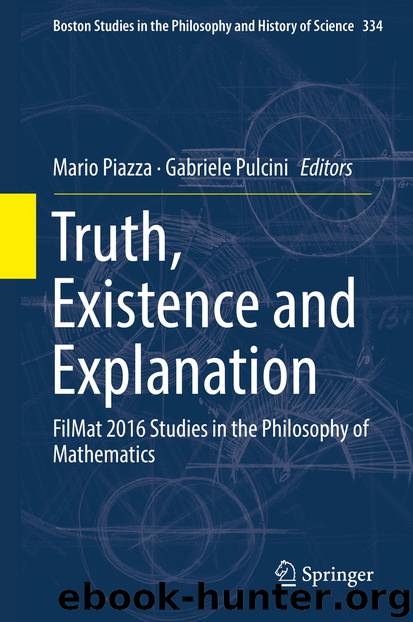Truth, Existence and Explanation by Mario Piazza & Gabriele Pulcini

Author:Mario Piazza & Gabriele Pulcini
Language: eng
Format: epub
ISBN: 9783319933429
Publisher: Springer International Publishing
As stated earlier, whether each instance is viewed as adding a diagonal layer of “steps” to the previous iteration, or a vertical column of squares to the left of the previous iteration, seeing the diagram as built sequentially seems essential to generalizing it. The indefinite iteration of such diagrams, then, matches the indefinite iteration of quantities on the left hand side of the equation.
Second it is the implicit induction on this sequence of diagrams that justifies the result. One must induce to the general conclusion that for all n, the diagram retains the same shape. And this depends on seeing the constructive relationship between one diagram and the next: that when you construct the (n + 1)th case from the nth case (by adding n + 1 squares to the nth construction) the shape-type remains the same.
That inductive reasoning on the (perhaps imagined) sequence of diagrams is necessary to back up the general inference means that the lone diagram does not serve as a (full) proof.35 Nor, as I have indicated, is it necessarily better than a proof. However, our question is not whether diagrams are proofs, or are better than proofs. Our question is more broadly epistemic: whether, despite not being a proof, the diagram nevertheless has a normative, justifying role – a role less than that of a proof but more than that of a mere cause, or psychological aid. And further, if the diagram has more epistemic power than a mere psychological aid, from whence does it derive this power?
The answer I have proposed is that such images and diagrams can have normative power, and this power comes from the fact that they share critical structural properties with the facts or theorems they represent (as well as with their verbal/symbolic representations). Thus, such diagrams need not be mere causes. Though their justifying power falls short of proof, the structuralist perspective provides a good explanation for the justifying power, and therefore the epistemic status, that they do have.
This power, or status, also explains why visual tools are so useful for producing mathematical understanding. That is, because the structuralist perspective can account for the epistemic (v. psychological) power of certain diagrams, it also accounts for their role in promoting understanding. In the case considered here, understanding is produced by seeing that the sequence and pattern of the geometric object match the sequence (left hand side) and result (right hand side) of the arithmetic equation. Seeing that two sequences are the same, despite differences of content (visual/spatial vs. symbolic/numerical) involves recognizing their shared structure. Thus the structuralist perspective explains a commonly held view about the importance of visualization, and the power of images, in mathematics, and their effectiveness as a tool for promoting mathematical understanding.36
Download
This site does not store any files on its server. We only index and link to content provided by other sites. Please contact the content providers to delete copyright contents if any and email us, we'll remove relevant links or contents immediately.
Deep Learning with Python by François Chollet(12593)
Hello! Python by Anthony Briggs(9928)
OCA Java SE 8 Programmer I Certification Guide by Mala Gupta(9804)
The Mikado Method by Ola Ellnestam Daniel Brolund(9787)
Dependency Injection in .NET by Mark Seemann(9348)
Algorithms of the Intelligent Web by Haralambos Marmanis;Dmitry Babenko(8310)
Test-Driven iOS Development with Swift 4 by Dominik Hauser(7772)
Grails in Action by Glen Smith Peter Ledbrook(7705)
The Well-Grounded Java Developer by Benjamin J. Evans Martijn Verburg(7567)
Becoming a Dynamics 365 Finance and Supply Chain Solution Architect by Brent Dawson(7187)
Microservices with Go by Alexander Shuiskov(6951)
Practical Design Patterns for Java Developers by Miroslav Wengner(6868)
Test Automation Engineering Handbook by Manikandan Sambamurthy(6813)
Secrets of the JavaScript Ninja by John Resig Bear Bibeault(6426)
Angular Projects - Third Edition by Aristeidis Bampakos(6230)
The Art of Crafting User Stories by The Art of Crafting User Stories(5746)
NetSuite for Consultants - Second Edition by Peter Ries(5674)
Demystifying Cryptography with OpenSSL 3.0 by Alexei Khlebnikov(5490)
Kotlin in Action by Dmitry Jemerov(5075)
